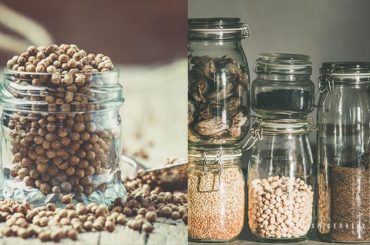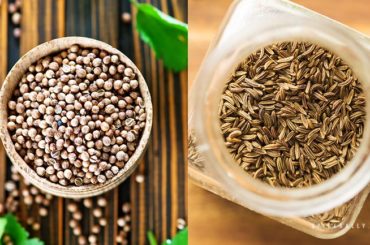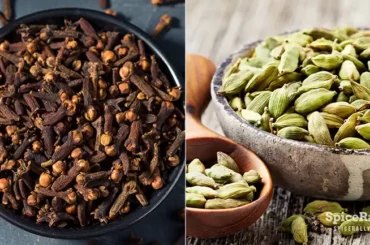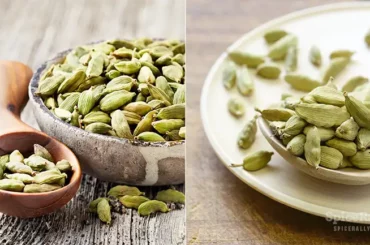Cardamom, popularly known as the “Queen of Spices” in Indian cuisine is one of the most valuable culinary spices in the world. This is available in the store as pods and powdered but it is also feasible to grow green cardamom at home.
This spice is a tropical perennial herb that requires warm and humid agro-climatic conditions to succeed. You can grow a cardamom in your back garden using seeds or a plant from your local gardener. This plant needs a lot of water, partial shade, and special protection from chilly weather. You could get the harvest from a cardamom plant after about three years from planting.
So, let’s move on to the depth of this article and find out how you can have your own cardamom cultivation at home.

How To Grow Green Cardamom In Your Home Garden?
Aromatic, spicy, minty, and flavorful cardamom is one of the best ingredients in various dishes. You must be buying this spice quite often from the store. But, have you ever thought of having your own cardamom plant? Here’s how you can have them in your home garden!
Green cardamom is a plant that thrives best in tropical climates. But it doesn’t mean you can’t have it if you live in a cold area. This plant can be grown easily outdoors if you reside in hardiness zones 10-13. The plant thrives best in well-drained deep loam and loamy clay soils with rich organic matter.
Can Green Cardamom Be Grown Indoors?
Even living in hardiness zones 10-13, you must take your cardamom plant indoors during winter. It can work as a houseplant but it rarely blossoms when grown in a container. Therefore, you can’t expect your plant to produce flavorful seeds indoors for your culinary applications.
Plant Overview
Cardamom, also known as “cardamon” or, “cardamum”, is a perennial herbaceous plant with a pseudo stem and stout irregularly shaped rhizomes. It is widely used as a popular culinary spice made from the seeds of multiple plants genera Elettaria and Amomum in the family Zingiberaceae.
Green cardamom initially came from wild plants in the Western Ghats in Southern India. Leafy nodes of the cardamom plant emerge 5 to 20 feet from the branching rootstock. Flowering sprouts, about 3 feet long, may be erect or sprawling.
Each bears multiple flowers about 2 inches in diameter with purple-veined white lips and greenish petals. The reen three-sided oval capsule is the whole fruit possessing 15 to 20 deeply aromatic, reddish brown to brownish black, angular, hard seeds.
Cardamom can reach a height of 16.4 ft and has a productive lifespan of 10-15 years.
Growing Requirements
Before you grow green cardamom in your home garden, it is essential to make a favorable environment for the plant to grow. First thing, cardamom requires a lot of space to grow.
Thus, freeing a separate space from your backyard to grow this plant would be the best. In addition, this also needs well-drained, loamy soils without water-logged or eroded soils. The soil pH level should be 4.5 to 6.0.
The most favored temperature for cardamom to thrive is 10-25 degrees Celsius. Your plants should get a well-distributed rainfall between 1500-2000 mm annually. If not, they need a lot of water which you may ought to water more during the summer.
Starting To Grow Using The Seeds
Choosing and Gathering the Seeds
There are two ways to get the cardamom seeds in order to grow green cardamom. The easiest way is to get the seeds from the pods you already have at home.
However, if you’re using seeds from pods, you must look out for fresh pods with quality seeds. If you are gathering seeds from a plant, it is advisable to gather them from a plant at least 5 years old. The next way to get the seeds is to collect them from an agricultural supply store.
The benefit of collecting seeds from an agricultural supply store is that these seeds could be potentially free from diseases and have a higher chance of thriving. You may check out a physical store or even order online.
Planting
You may start by choosing a container. You can use a container of any size to transplant the seedlings to your outdoor garden. But, you should use a pot at least one foot deep and six inches wide if you leave the seeds in it and plan to grow the plants until maturity.
The soil should be barely sandy so it drains slowly. You can buy loamy soil from most garden stores. Press a few seeds into the container and cover each with 1⁄8 inch of soil. Water the seeds so the soil is entirely moist.
Plant as many cardamom seeds as you like, but sow them about 1 inch apart in the pot so you can disperse and transplant them once they start producing. Your plant should sprout after about 30 to 45 days.
This means you should notice the cardamom plants begin to spur up through the soil. Keep watering so the soil stays damp. You should leave the seedlings in the pot until you see at least leaves on the seedlings. This process will take around 90 days (03 months) for the seedlings to become big enough to be transplanted outdoors.
Transplanting
Choosing The Location In Your Garden
Choose an area in the garden with well-draining soil. You must pay attention to the soil after a hefty rain to see how it drains. Watch out for deep puddles. But the soil should remain moist. Remember that it could kill your cardamom plant if the soil is too rich in clay.
So find somewhere else in the garden or combine sand into the soil to break up the clay. Also, cardamom plants will fail if they’re in direct sunlight. Thus, pick a planting location that has partial shade. It will work out if you only have a fully shaded area but the plant may not grow as quickly as expected.
Cardamom plants typically grow under the canopy of trees that are above them. Since these plants grow in subtropical forests, they require high humidity to succeed in your garden. To plant the cardamom outdoors, the humidity needs to be around 75%.
Processing
Dig one-inch deep pits that are 6 to 18 inches apart. Position 1 seed into each pit and envelop the seed roots with dirt. If you would like to help the plants as they grow, push a garden stake into the soil 2 inches away from the base of each plant. So, as the plant grows, you can hook the plant to the stake.
PRO TIP : Avoid planting seeds by plunging deeper since they may not germinate if they don’t get sufficient sunlight. If you live in an environment with temperatures that occasionally drop below 60 °F, you may want to sow the seedlings in large pots instead of outdoors in the garden.
This makes bringing the cardamom indoors when it gets cooler outside is easy. If you use a container, choose as large as you can for your room that’s also comfortable to pick up to move in and out of your house. If you plan to bring the cardamom plant inside your house, place it in the most humid, warmest room. (preferably your bathroom).
Watering
Touch the soil with your fingers every day to confirm that the soil is damp. Keep in mind that the soil should never dry out. Water until the soil is well-saturated. Your cardamom plants will need even more water during the summer when they’re developing the fruits.
Therefore, make your watering schedule more frequent during these months. Misting your cardamom plants often will help mimic their native rainforest-type growing conditions.
You can use a clean garden spray bottle to do this. Choose a time before noon and a time slot in the evening around 4.00-5.00 PM to mist your plants.
Applying Fertilizer
When you grow green cardamom, select an organic fertilizer with high phosphorus content and scatter it in the soil around the cardamom plants. It would be best to apply fertilizer two times a month during the summer producing season.
You’ll also need to apply compost or aged manure once a year to add nutrients to the soil. Heavy rain will cleanse away fertilizer, so stay patient to use it until after a storm or heavy rain.
Controlling Pests and Diseases
Pests and Management
The thrips are the most common insects in your cardamom plant. But on the bright side, you can potentially treat thrips with traps.
You may also notice proof of detrimental nematodes, exemplified in poor growth and ill-looking plants. If you reckon nematodes, excavate a plant and see if you can detect somewhat severe root damage.
This is caused by the tiny pests mining in, laying their eggs, and looting the plant of nutrients. If you have a nematode infestation, you may have to eliminate your plants and treat the soil with a chemical nematicide or by solarization to eradicate the insects.
Diseases and Management
Your cardamom plants could be disturbed by oomycetes or fungi. You can prevent the spread by supporting the growing area clean and withdrawing dead plant matter. You can also treat these issues with an organic fungicide.
Harvesting
You should wait until your plants grow to six to ten feet. Keep watering the plants frequently and fertilize them as required. The plants will start to grow tall, slender stalks that go high off of the ground.
Remember that it will take a few years for your cardamom plants to be grown to a fully grown plant. The stalks will produce bright green leaves that are about 2 inches long. It will take about two to three years for the fruits to grow.
Cardamom flowers are yellow, oval and hold capsules that contain cardamom seeds. However, you shouldn’t panic since some plants may take up to 4-5 years to bloom.
Method of Harvesting
You should pick the cardamom capsules by hand. Once the capsules of cardamom fruit start to dry out a little, remove one to see if it breaks easily. You can pull off all the ripe capsules, if the fruit cracks effortlessly.
Cardamom plants will usually keep producing more cardamom seeds every year. This is harvested 5 or 6 times throughout one harvest year. Stay patiently for 35 to 45 days in between each gathering, so more of the cardamom can ripen.
Drying and Preparing For Culinary Applications
Depending on how many capsules you want to dry, you can use various drying methods. You may scatter the cardamom in a single layer for minor drying and let the sun dry the pods.
Commercial or larger harvests often dry cardamom using powerfully hot kilns. Once the cardamom pod is dry, you can open the capsules and grind the cardamom to cook or bake with if needed.
Green Cardamom is Probably One Of The Most Precious Plants To Have At Home!
If you’re an enthusiastic gardener who loves exploring new plants and also a spice lover at the same time, we hope this guide helps you big time! As you see, green cardamom is not hard to grow but you need to give it constant attention and care to get the best results. And, unlike most herbs, cardamom takes several years after planting to give the harvest you expect.




